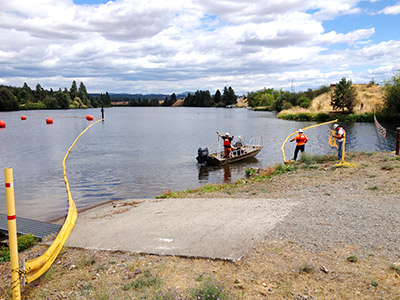New oil spill response plans from the Washington Department of Ecology will address the increasing chance of oil spills along train routes in central and eastern Washington.
Six out of 11 new draft plans released for the public to review will cover areas on the east side of the mountains along oil train routes. Five plans in western Washington will address potential spills from pipelines and railroads.
The new “geographic response plans” take the guesswork out of the response during the first 12 hours of the spill. They signal where to place oil containment equipment and which agencies and governments to notify. They identify specific actions that can be taken locally to protect bird and fish habitat, wetlands, water intakes, fishing areas, fish hatcheries, boating areas and public parks and beaches, and cultural resources like petroglyphs, ancient tools and fish weirs.
The plans are part of a larger effort that guides a coordinated response to oil spills in Washington, Oregon and Idaho, according to Dale Jensen, who manages Ecology’s Spills Program. “Geographic response plans build on our focus to prevent oil spills to water and land and are part of our up-front planning that helps us deliver a rapid, aggressive and well-coordinated response to oil and hazardous substance spills wherever they occur,” he said.
For decades, Ecology has prepared similar response plans for Puget Sound and other marine waters to ensure the state is ready for an accident involving tanker ships and refineries. The work has expanded due to the increasing amount of oil entering our state by railroads and pipelines.
The 11 new plans and their coverage areas:
- Lower Yakima River – 676 square miles in Benton, Kittitas, and Yakima counties
- Palouse – 253 square miles within Adams, Franklin and Whitman counties
- Puyallup-White Rivers – 207 square miles in Pierce and King counties
- Stillaguamish – 89 square miles in Snohomish County
- Upper Columbia River – 207 square miles in Chelan, Douglas, Grant and Kittitas counties
- Upper Green River – 120 square miles in King County
- Upper Yakima River – 439 square miles in Kittitas and Yakima counties
- Warden Washington – 131 square miles in Grant County
- Washington Deschutes – 312 square miles in Grays Harbor, Lewis and Thurston counties
- Wenatchee – 332 square miles in Chelan County.
Ecology plans to publish the 11 plans at the end of June along with plans for three additional new areas that were completed earlier this year, bringing the total number of geographic response plans in Washington to 41. The expansion of the plans in the state is a result of the 2015 Oil Transportation Safety Act, and highlights the state’s efforts to protect people and the environment from new oil spill risks.
Ecology is accepting comments on the plans until 5 p.m., June 15. Find out more online.


